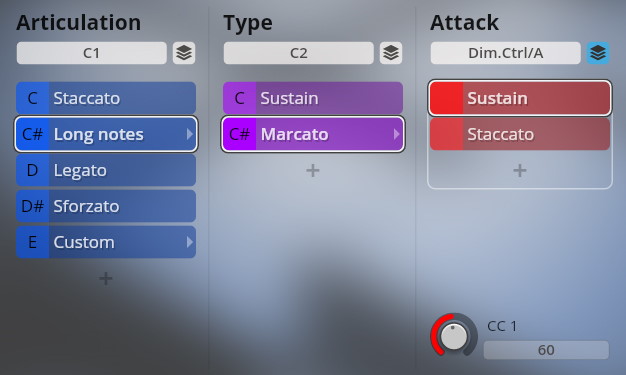SYNCHRON-ized Special Editions 4 - Special Winds, Choir & Voices
Introduction
Welcome to the Vienna Symphonic Library's series of Synchron Instruments! The SYNCHRON-ized Special Editions were specifically created to give our renowned Vienna Special Editions a chance to shine in the unique acoustic ambience of the Vienna Synchron Stage, and make the ease-of-use of the Vienna Synchron Player available to them, and you. This document will provide you with information about the Libraries' instruments and structure.
For creating SYNCHRON-ized Special Editions, our sound editors went back to the raw, unprocessed sample data of the Vienna Special Edition Collections. The original recordings were completely re-edited and re-mastered in order to achieve an all-new, modern sound that excels in terms of aesthetics, playability and realism, and that is optimized for use alongside the Synchron Series instruments.
Included Presets
For SYNCHRON-ized Special Editions, our software developers added a specifically designed convolution reverb derived from Vienna MIR Pro to the Synchron Player, featuring the outstanding and unique ambience of the 540 m2 (5,813 sq.ft.) main hall of Synchron Stage Vienna. The perfectly engineered reverberation and placement presets combine customized impulse responses with expertly crafted reverb settings for each group of the ensemble. By adding the ambience of Synchron Stage Vienna's Stage A to the dry samples in real-time, SYNCHRON-ized Special Editions perfectly blend with other products of our Synchron Series.
For each instrument, there are dedicated Mixer Presets that depict different recording situations: Close, Classic, Distant, short and long reverb without convolution.
Sound categories
The Presets of each instrument group are subdivided into different Articulation categories (plus one named "Custom", ready for your own creations).
Strings
- Short Notes
- Long Notes
- Legato
- Dynamics
- Tremolo + Trills
- Pizzicato + Legno
- Harmonics
- Sul ponticello
- Con sordino (Orchestral strings)
Wind instruments
- Short Notes
- Long Notes
- Legato
- Dynamics
- Trills + Fast repetitions
Within these Articulation categories, you can select a Type (if applicable), e.g., staccato or détaché, and for some of the types there are additional options available, such as marcato attack or tremolo control.
The articulations of other instruments, such as percussion and keyboards, depend on the specific instrument's requirements and capabilities.
Custom Presets
Apart from its respective categories, every instrument also features a slot named "Custom Preset". It does not yet contain any samples, and provides slots ready for you to load patches and configure presets of your own.
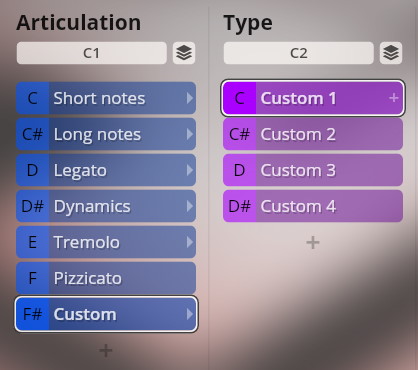
About Patches
Patches can be used to build your own custom Presets and adapt the Synchron Libraries to your specific requirements. If you want to create Presets of your own, using the instruments' Custom Preset template provides a good starting point.
About Pitch
For designating pitch, the Vienna Symphonic Library uses International Pitch Notation (IPN), which was agreed upon internationally under the auspices of the Acoustical Society of America. In this system the international standard of A=440 Hz is called A4 and middle C is C4. All pitches are written as capital letters, their respective octave being indicated by a number next to it. The lowest C on the piano is C1 (the A below that is A0), etc.
The Synchron Player software allows you to set middle C to C3, C4, or C5 according to your preference. Selecting another setting than C4 will of course also change the play ranges and keyswitches accordingly.
Walkthrough Videos
Special Edition 4 – Presets
Special Edition 4 offers less frequently used wind instruments such as bass flute and flugelhorn, as well as vocal ensembles and solo voices.
By default the keyswitch mappings for Articulations start at C1 (for Middle C = C4) for treble and mid-range instruments (e.g., violins, clarinet), and C6 for low instruments (double basses, bassoon). For the available Types, the keyswitches start at C2 for higher instruments, and at C7 for lower ones.
Additional options within Articulations or Types are offered by the Dimension Controllers. The controller function is indicated by the respective caption, as of course it may take on different tasks as needed.
Winds
Woodwinds: bass flute, English horn II (Viennese), heckelphone, contrabass clarinet, bassoon II, soprano saxophone, bass saxophone.
Brass: trumpet II in Bb normal and muted, bass trumpet, trumpet ensemble (6 players), alto trombone, euphonium, cimbasso.
Voices: sopranos (16 voices), altos (10 voices), tenors (10 voices), basses (8 voices), as well as soloists.
Staccato
There are no further options for this articulation.
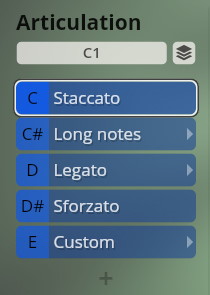
Long notes
Sustained notes, normal and with marcato crossfading.
With the marcato option, use Dim.Ctrl/A (CC1) to add marcato attacks to the notes.
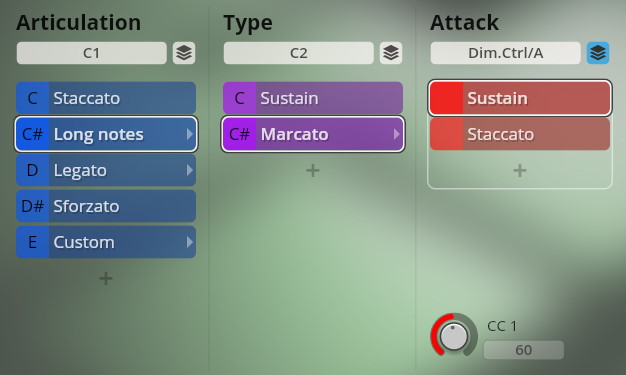
Legato
Performance legato. Apart from the regular articulation, some of the instruments (.e.g, the saxophones) also feature legato with looped sustains.
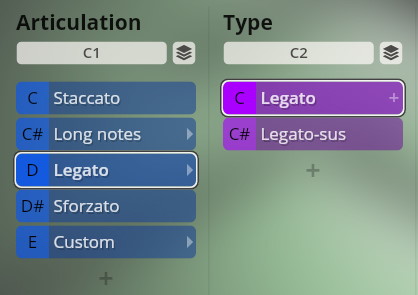
Sforzato
There are no further options for this articulation.
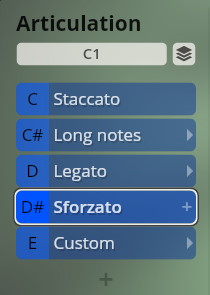
41 Voices
Choir: sopranos (16 voices), altos (10 voices), tenors (10 voices), basses (8 voices).
Solo voices: soprano, alto, tenor, bass.
For the choir voices there also is a dedicated Preset which combines all four timbres. Please note that this Preset does not contain legatos.
Staccato, legato, sforzato
There are no further options for these articulations.
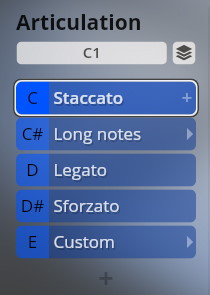
Long notes
Sustained notes, normal and with marcato crossfading.
With the marcato option, use Dim.Ctrl/A (CC1) to add marcato attacks to the notes.
